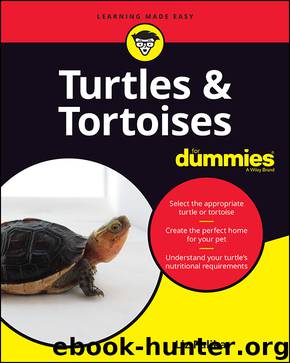Turtles and Tortoises For Dummies by Liz Palika

Author:Liz Palika [Palika, Liz]
Language: eng
Format: epub
ISBN: 9781119695523
Publisher: Wiley
Published: 2020-04-07T00:00:00+00:00
Star Tortoise (Geochelone elegans)
This is one of the world’s most beautiful tortoises. It has been collected in the wild in large numbers, depleting many populations. The star tortoise averages about 6 inches in length for males, with 15 inches the maximum. The carapace is domed, although it appears lumpy, with each scute having a slightly raised center. The carapace has a dark brown or black background with radiating white or yellow stripes on each scute. The plastron is yellow with black radiating stripes. The head and skin are yellow to tan.
The star tortoise is on the CITES II list, which means that it’s protected. Never buy a wild-caught star tortoise; not only may it have been imported illegally, but wild-caught tortoises have a difficult time adjusting to captivity. Star tortoises are now being bred in captivity, and these pets are healthier than their wild cousins and don’t have adjustment problems. Buy a captive-bred baby!
Geographical origin: India and Sri Lanka (Ceylon).
Native habitat: Deciduous forests, grasslands, and dry savannas. Habitat destruction is endangering many wild star tortoises. Overcollection for the pet trade has also been a problem.
Captive environment: Provide a standard terrestrial tortoise enclosure, and keep the enclosure on the dry side, watering the grass while the tortoise is under shelter (that is, in a tortoise house or otherwise protected from dew, rain, or sprinklers). A doghouse with an incandescent red bulb provides heat, shelter, and a hiding place. Give your star tortoise hiding places and basking areas.
Keep hatchlings and juveniles inside. Supply a long, low terrarium (see Chapter 3), using alfalfa pellets as substrate. Maintain a basking spot at 85 to 90 degrees, with the rest of the terrarium cooler. A fluorescent reptile light can supply needed UVB rays. As soon as the tortoise is large enough or you have a protected area, move the tortoise outside: These tortoises don’t thrive indoors for long periods.
Star tortoises do better in a group, perhaps two males and several females. Don’t mix them with other species of tortoises, however; they don’t have resistance to diseases that are common in other species.
Download
This site does not store any files on its server. We only index and link to content provided by other sites. Please contact the content providers to delete copyright contents if any and email us, we'll remove relevant links or contents immediately.
| Birds | Cats |
| Dogs | Essays |
| Fish & Aquariums | Food & Nutrition |
| Horses | Insects & Spiders |
| Mice, Hamsters & Guinea Pigs | Pet Loss |
| Rabbits | Reptiles & Amphibians |
Finding Gobi by Dion Leonard(2779)
Grumpy Cat by Grumpy Cat(2681)
A New Earth: Awakening to Your Life's Purpose by Eckhart Tolle(2591)
The Silkworm by Robert Galbraith(2441)
Tippi by Tippi Hedren(2180)
End of Days by Sylvia Browne(2114)
Total Cat Mojo by Jackson Galaxy(1967)
Backyard Chickens Beyond the Basics by Pam Freeman(1902)
The Animals Among Us by John Bradshaw(1830)
The Ultimate Pet Health Guide by Gary Richter(1725)
All Things Bright and Beautiful by James Herriot(1705)
Vet in Harness by James Herriot(1663)
Doggy Desserts: 125 Homemade Treats for Happy, Healthy Dogs by Cheryl Gianfrancesco(1652)
Dog Years by Mark Doty(1642)
Cesar's Way by Cesar Millan(1632)
Chicken Soup for the Ocean Lover's Soul by Jack Canfield(1597)
Dog Training 101 by Kyra Sundance(1556)
Walking with Peety by Eric O'Grey(1553)
Animal Speak by Ted Andrews(1513)
